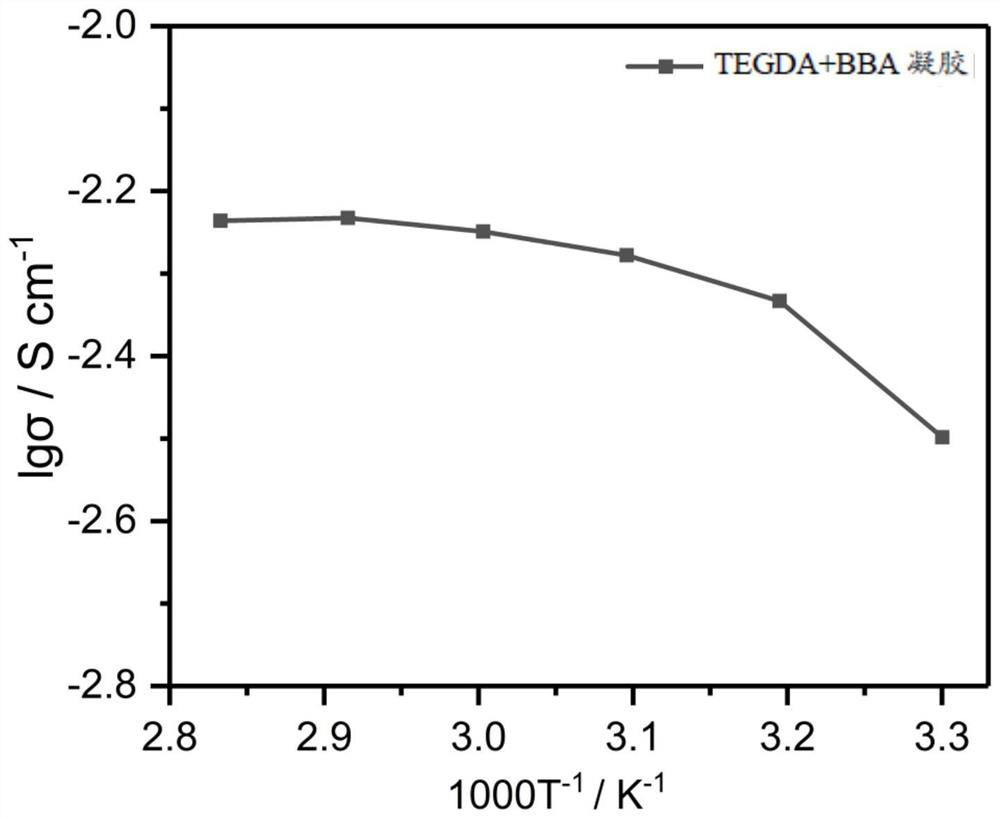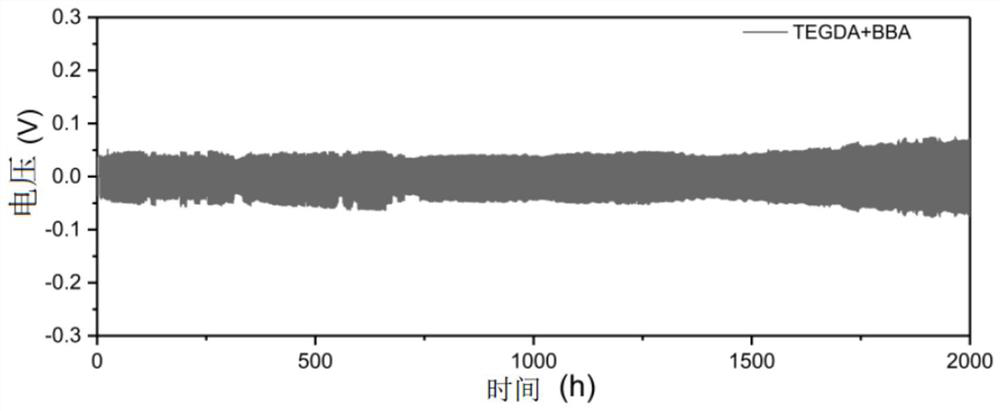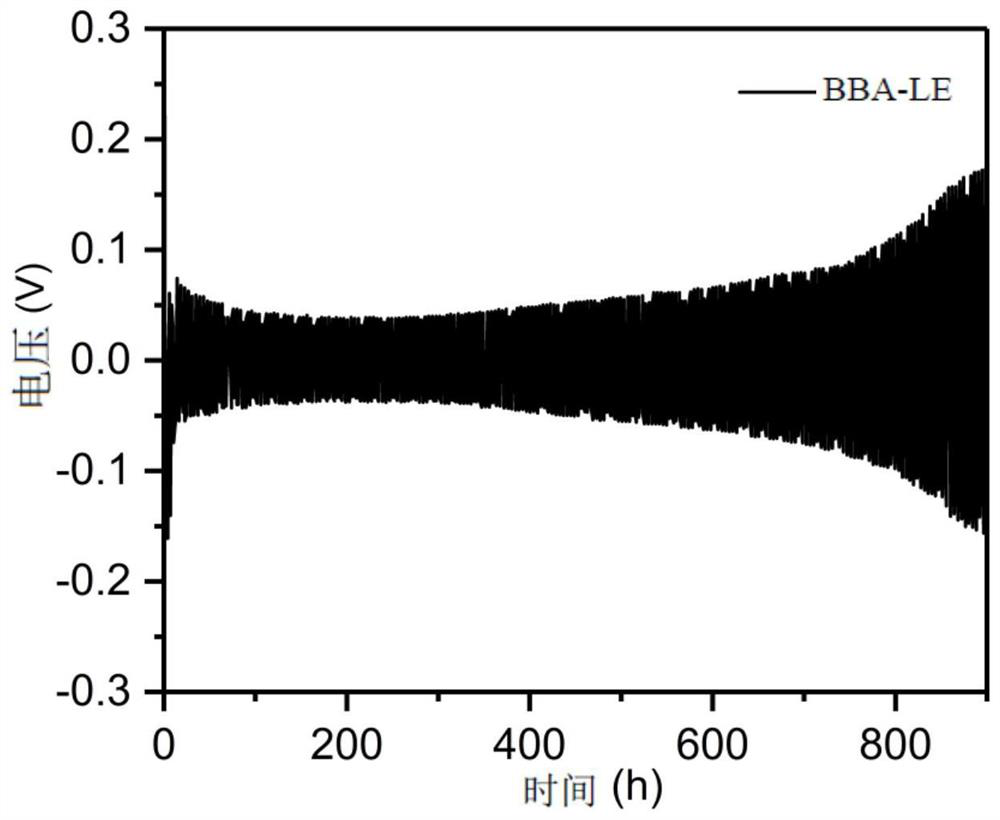Gel electrolyte as well as preparation method and application thereof
A gel electrolyte and electrolyte salt technology, applied in the field of electrochemistry, can solve problems such as interface deterioration, leakage, and poor contact
- Summary
- Abstract
- Description
- Claims
- Application Information
AI Technical Summary
Problems solved by technology
Method used
Image
Examples
Embodiment 1
[0096] Specific steps:
[0097] (1) The organic solvent used is ethylene carbonate and diethyl carbonate, the volume ratio is 1:1, and the lithium salt used is 1M lithium hexafluorophosphate (LiPF 6 ), be made into homogeneous solution I;
[0098] (2) Add 0.23mol L to the homogeneous solution I under an argon atmosphere -1 Triethylene glycol diacrylate (TEGDA), initiator azobisisoheptanonitrile (ABVN), 0.02mol L -1 The trans-3-methoxy group-1-phenylboronic acid pinacol, stirring and dissolving into precursor solution I;
[0099] Add the precursor solution I into an all-solid-state battery with lithium iron phosphate as the positive electrode, lithium metal as the negative electrode, and a polypropylene film as the diaphragm, or a lithium metal symmetrical battery, and after the battery is assembled, let it stand at 30° C. for 12 hours. A solid-state lithium metal battery with an in-situ gel electrolyte using trans-3-methoxy-1-phenylboronic acid pinacol as an additive was ob...
Embodiment 2
[0101] Specific steps:
[0102] (1) The organic solvents used are dimethyl carbonate, diethyl carbonate, and ethylene carbonate, and the volume ratio is 1:1:1. The lithium salt used is 1M bistrifluoromethylsulfonylimide lithium salt. into a homogeneous solution II;
[0103] (2) Add 0.10mol L to the homogeneous solution II under argon atmosphere -1 Pentaerythritol tetraacrylate, initiator azobisisoheptanonitrile (ABVN), 0.02mol L -1 The n-butyl boric acid, stirring and dissolving into precursor solution II;
[0104] Add the precursor solution II to an all-solid-state battery with lithium iron phosphate as the positive electrode, lithium metal as the negative electrode, and a polypropylene film as the diaphragm, or a symmetrical lithium metal battery. After the battery is assembled, let it stand at 30°C for 12 hours. A solid-state lithium metal battery with an in-situ gel electrolyte with n-butylboronic acid as an additive was obtained.
Embodiment 3
[0106] Specific steps:
[0107] (1) The organic solvent used is dimethyl carbonate, diethyl carbonate, ethylene carbonate, the volume ratio is 1:1:1, and the lithium salt used is 1M lithium hexafluorophosphate (LiPF 6 ) to form a homogeneous solution Ⅲ (LE);
[0108] (2) Add 0.23mol L to the homogeneous solution III under argon atmosphere -1 Triethylene glycol diacrylate (TEGDA), initiator azobisisoheptanonitrile (ABVN), 0.02mol L -1 n-Butylboronic acid (BBA), stirring and dissolving into precursor solution III;
[0109] Add the precursor solution III to an all-solid-state battery with lithium iron phosphate as the positive electrode, lithium metal as the negative electrode, and a polypropylene film as the separator, or a symmetrical lithium metal battery. After assembling the battery, let it stand at 30°C for 12 hours. A solid-state lithium metal battery (BBA+TEGDA) with an in-situ gel electrolyte with n-butylboronic acid as an additive was obtained.
PUM
 Login to View More
Login to View More Abstract
Description
Claims
Application Information
 Login to View More
Login to View More - R&D
- Intellectual Property
- Life Sciences
- Materials
- Tech Scout
- Unparalleled Data Quality
- Higher Quality Content
- 60% Fewer Hallucinations
Browse by: Latest US Patents, China's latest patents, Technical Efficacy Thesaurus, Application Domain, Technology Topic, Popular Technical Reports.
© 2025 PatSnap. All rights reserved.Legal|Privacy policy|Modern Slavery Act Transparency Statement|Sitemap|About US| Contact US: help@patsnap.com



